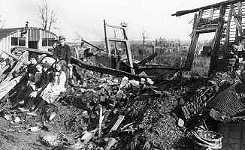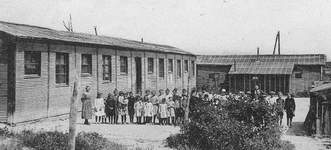
A woman and her children posing middle of the ruins. This family stays in a sort of caravan. One can see wall sections and the numerous wreckages. |
Hamel is part of the 381 villages of
the East of the Somme which had known destructions. If the village was
not entirely levelled to the ground as, for example, some places concerned
by the battle of the Somme in 1916, few houses were still standing at the
end of the war. An inhabitant would have recognized his farm among ruins
thank to the place of the yard and a wall section. It's hard to imagine
what villagers might have felt when they found their home destroyed. Of
their only real possession bought by themselves or ancestors after working
hard and saving money, almost nothing remains.
|

Still a mother and her children sat on the ruins of their home. On left, their provisory housing. On the background, one can see a house. The one were the French flag was hang after the capture of the village. |
Because of the importance of destructions,
inhabitants were not back before 1919. They had often taken refuge dozens
of kilometres away since the village was evacuated on 26 March 1918. Municipalities
elected people were the first allowed to visit the destroyed villages.
Some inhabitants who had the means to travel and to get a pass could also
made the trip and saw the destructions.
|

Remains of the village church (click to compare). The road has been cleared. Men on the picture seem to be Australians; we don't know what they were doing there. On the right, branch of one of the village square lime trees. |
Except the problem of the housing,
it was not possible to live in the village of other reasons. First, it
was not possible to work. The soils was not cultivable, farming tools had
vanished or were damaged, no more farming buildings or cattle. The tiny
factory and their weaving looms were destroyed. Also, it was impossible
for children to go to school. The town hall, the church, cafés,
shops and other places necessary to village life were also missing.
|

The main factory of the village in March 1919. The only one which was rebuilt. |
Transportations are also disorganized.
Roads and rail tracks closer of the front are damaged. Despite the destructions,
Hamel and other villages were rebuilt and according to the same plan. It
was far to be evident. For a little time, French government had an other
project. It wanted to replace the more destroy villages by state forests.
What has been done for razed villages around Verdun. But in the Somme,
the project encountered a very strong opposition from mayors and inhabitants
of the concerned places.
|

Remains of one of the big weaving looms of the factory. |
So Hamel and most of the villages war
victims were rebuilt. The will-power of the inhabitants and their representatives
certainly play a big role in the choice of the reconstruction. But the
place of the textile industry and a relatively efficient agriculture also
contribute to that choice. With respect to the involving costs, what Germany
had to pay to France was supposed to cover war damages to all kinds of
victims.
|



